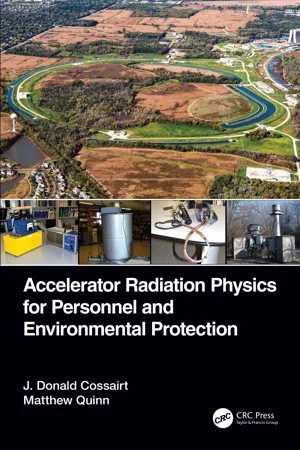Physics
Units Physics
Units in physics refer to the standardized measures used to quantify physical quantities such as length, mass, time, and energy. These units provide a common language for scientists to communicate and compare measurements. The International System of Units (SI) is the globally accepted standard for units in physics and other scientific disciplines.
Written by Perlego with AI-assistance
Related key terms
7 Key excerpts on "Units Physics"
- Edward W. Finucane(Author)
- 2023(Publication Date)
- CRC Press(Publisher)
Chapter 1 The Basic Parameters and Laws of Physics and Chemistry DOI: 10.1201/9781003420002-1The basic parameters or measurements of the physical sciences (including all of the most common and widely used units that apply to each) will be identified and described in this chapter. In addition, the fundamental laws that find significant usage in the overall study and practice of industrial hygiene/occupational safety and health also will be covered in detail.Relevant Definitions
Basic UnitsThere are seven basic or fundamental units of measure in current use today throughout the world. The most widely recognized set of these units, known as the International System of Units (SI), was initially adopted in 1960, and is reviewed and amended, as deemed necessary, at one of the General Conferences on Weights and Measures, an international meeting that convenes periodically. In addition, there are two common “metric” systems, referred to in the text that follows as the MKS System (meters, kilograms, and seconds), and the CGS System (centimeters, grams, and seconds), as well as the “nonmetric” English System (obsolete almost everywhere on Earth, except in the United States). Each of these Systems of Units will be covered.Length
Length is the extent or distance from one end of an object to the other, or a distance in space from one clearly identified point to any other such point.In the International System of Units, the basic unit of length is the meter, which has been defined as the length of path traveled by light in a vacuum during a time interval of 1/299,792,458 of a second.In the MKS System, the basic unit of length is the meter. In the CGS System, the basic unit of length is the centimeter. In the English System, the basic units of length can be either the foot, the inch, or the yard.Mass
In physics, mass is the measure of a body’s resistance to acceleration. The mass- eBook - ePub
- Atef Korchef(Author)
- 2022(Publication Date)
- CRC Press(Publisher)
2 Measurements
DOI: 10.1201/9781003257059-22.1 Objectives
At the end of the present chapter, the student should be able to:- Select the appropriate units in the International System of Units (known by the international abbreviation SI) of measurement.
- Differentiate between fundamental quantity and derived quantity.
- Convert units.
- Define and use the basic methods and tools of measurements, such as significant figures and rounding off.
2.2 Measurements
Measurement is the process of comparing an unknown quantity with another known quantity of the same kind to find out how many times the first includes the second.- Physical quantities are either fundamental (basic) quantities or derived quantities.
- Fundamental quantities cannot be defined in terms of other physical quantities.Examples: length, time, mass, temperature and amount of a substance.
Quantity consists of a number telling us how much, and a unit which shows what the scale of measurement is. Examples of base units in SI are given in Table 2.1 . SI base units of mass, temperature and amount of a substance (kg, K and mol, respectively) are widely used by chemists (Table 2.1 ).TABLE 2.1 Examples of SI base units
Note that:Base quantity SI base unit Name Symbol Name Symbol Length l, x, r, etc meter m Mass m kilogram kg Time t second s Temperature T Kelvin K Amount of a substance n mole mol - The SI unit of mass is kg (with small or lowercase k), not Kg (with capital K).
- The SI unit of the amount of a substance (mole) is denoted by mol (without an “e”), not mole. Also, kg is not the SI base unit for the amount of a substance but the SI unit of mass.
- eBook - ePub
Energy Efficiency
Concepts and Calculations
- Daniel M. Martinez, Ben W. Ebenhack, Travis P. Wagner(Authors)
- 2019(Publication Date)
- Elsevier Science(Publisher)
It is also worth being clear on the terms “units” and “dimensions,” although, sometimes used interchangeably, dimensions are universal combinations of length, time, mass, temperature, light, and number of atoms or molecules. The basic units that we use have specific quantities associated with them, such as meters or feet as “units” of the dimension “length.” This would be a base unit, but many units we use combine multiple dimensions. “Velocity” is the ratio of unit “length” (often expressed as “distance” in this application) to unit “time.” It is often more convenient to combine all of the dimensions involved in a common phenomenon into a single “unit of convenience.”For example, viscosity, the resistance of a fluid to flow, is commonly reported in “centipoise” but even those of us who use viscosities regularly may need to look up that the dimensions of this unit of convenience are mass multiplied by length multiplied by time. The centipoise quantifies an observable property of a fluid more descriptively than to refer to how many g·cm·s a fluid has. Nevertheless, when ensuring that an equation yields the correct units, it can be very helpful to return to the basic dimensional analyses, to be certain that all of the extraneous dimensions in the equation cancel.2.2 Systems of Measurement, Common Units, and Prefixes of Energy
There are two systems of measurement commonly used by the world: The United States uses the United States Customary System (USCS) of feet, pounds, and seconds; and the rest of the world uses the International System (SI) of meters, kilograms, and seconds. So, whereas most countries regularly use kilometers, kilograms, liters, and joules in everyday life, the United States still uses miles, pounds, gallons, and British thermal units (Btu). Also, many engineering disciplines continue the tradition of this old, originally British system, so it does not seem like there will be a move away from the USCS any time soon.Though tedious, converting between various units is fairly straight forward, as energy equivalencies are calculated relative to a certain proportionality. If the conversion is merely needed to convert between two units of energy found in the different measurement systems, such as in converting J to Btu (or vice versa), the proportionality constant will be a ratio of those two values and have units of Btu/J (or vice versa). If the conversion is needed to convert between a certain quantity of fuel and its energy content, then the proportionality constant would also be a ratio of those two values but have units of J/kg of coal or Btu/gal of gasoline (and vice versa). - J. Donald Cossairt, Matthew Quinn(Authors)
- 2019(Publication Date)
- CRC Press(Publisher)
1 Basic Radiation Physics Concepts and Units of Measurement1.1 IntroductionOur study begins with a review of the standard terminology of radiation physics. The most important physical and radiological quantities and the system of units used to measure them are introduced. Due to its importance at most accelerators, the results of the special theory of relativity are reviewed. The energy loss by ionization along with the multiple Coulomb scattering of charged particles is also summarized.1.2 Units of Measure and Physical QuantitiesTo develop an understanding of accelerator radiation physics, it is necessary to introduce the quantities of importance and the units by which they are measured. Over the years various systems of units have been employed. Presently in the United States there is a slow migration toward the use of the Système Internationale (SI) nearly universally employed elsewhere. This requires the practitioner to understand the interconnections of the units, both those “customary” in the United States and SI, due to the diversity found in both the scientific literature and government regulations. As always in technical work the wise practitioner conducts a careful unit analysis of all calculations to assure meaningful results.Several quantities commonly used in physics are relevant to the subdiscipline of radiation physics. The unit of measure of the energy of particles is nearly always the electron volt (eV). This choice is usually much more convenient than the use of the Joule, the SI unit of energy: 1.0 eV is the kinetic energy of a particle carrying one electron’s worth of electric charge (positive or negative) after acceleration through an electric potential of one volt. It is equal to 1.602 × 10− 19 Joules. Multiples in common use at accelerators are the keV (103 eV), MeV (106 eV), GeV (109 eV), and TeV (1012 eV). Nearly always in discussions of particles at accelerators, the “energy” of an accelerated particle refers to its kinetic energy- eBook - ePub
- Mike Aitken, Bill Broadhurst, Stephen Hladky(Authors)
- 2009(Publication Date)
- Garland Science(Publisher)
CHAPTER 1 Quantities and UnitsFigure 1.1The authors, Mike, Steve, and Bill, holding a protein sample destined for the 500 MHz NMR spectrometer in the background. Image courtesy of Mike Aitken, Bill Broadhurst, and Steve Hladky.As scientists, we need to make quantitative statements about the physical quantities measured in our experiments. Algebra provides the language and grammar to make these statements. In this language the sentences are equations or inequalities whereas the words are symbols. A symbol may stand for a physical quantity or a number; for an operation such as addition or multiplication; or for a relationship such as ‘is equal to’ or ‘is greater than’. Often we use letters such as x, t, m, or A to stand for physical quantities such as distance, time, mass, or area. Symbols can also be special characters such as + for addition, or a combination of letters such as ‘sin’ for the sine function introduced in Chapter 4 .A physical quantity is a combination of a numerical value and a unit, for example a length of 1 m, a time of 2 s, or a mass of 70 kg, where the ‘m’ stands for meter, ‘s’ for second, and ‘kg’ for kilogram. Both are needed; if we change the unit the number changes accordingly. Many of the laws of science are expressed as simple equations relating physical quantities. A familiar example is F = ma where F, m, and a stand for force, mass, and acceleration. There are various systems for choosing units and conventions for how physical quantities are to be described. In this book we use the Système Internationale (SI) system of units, which has become standard for scientists and engineers throughout the world.1.1 Symbols, operations, relations, and the basic language of mathematicsIn the language of mathematics, the words are symbols like x, t, m, +, ×, ÷, =, >. Symbols can stand for numbers or for physical quantities; they can indicate operations or they can state relationships like ‘is equal to’ or ‘is greater than’. You first started using many of these symbols back in primary school where you learned what + and = mean. Even then you also used symbols to stand for unknown numbers in exercises like that shown in Figure 1.2 - eBook - ePub
The Reform of the International System of Units (SI)
Philosophical, Historical and Sociological Issues
- Nadine de Courtenay, Olivier Darrigol, Oliver Schlaudt(Authors)
- 2019(Publication Date)
- Routledge(Publisher)
Dimensions are to be distinguished from units and from quantities, although they are frequently confused with both of them, in print as well as in discussion, sometimes even in textbooks. Dimensions have to do with a constraint on equations, a constraint which we know the equations of physics, if we’ve gotten them right, must be subject to. Dimensions can be used to formulate a necessary and sufficient criterion for an equation to be homogeneous – even an equation containing undetermined quantities. The requirement that an equation be homogeneous is like the requirement that a sentence be grammatically correct; just as a sentence is not a proper sentence unless it is grammatically correct, so an equation is not a physical equation unless it is dimensionally homogeneous. Now, the question often arises as to whether one might just as well appeal to units for this purpose, and hence, whether it is possible to regard dimensions as superfluous (i.e., whether it is possible to hold that dimensions can be dispensed with, or, alternatively, to hold that dimensions just are units). Although this is often done, we shall see that things are not so easy, and that a lack of clarity about both units and dimensions is very lamentable and may have contributed to an ill-advised disregard for an appreciation of the role of dimensions.Dimensions appear in the New SI (Draft 9th SI Brochure ) just as they do in the current SI (SI Brochure 8th edition, 2014 update); they are referred to as “dimensions of quantities”. Each SI base unit has a unique dimension associated with it; the dimensions of other quantities are constructed from products of powers of these dimensions. The SI Brochure indicates as a rationale for providing dimensions only that “By convention physical quantities are organised in a system of dimensions” (BIPM, 2013, section 1.2, p. 3). This does not help much in understanding what dimensions are, nor in determining whether the fact that each base unit is associated with a unique dimension means that defining some units as base units is essential in the SI system. In order to understand what dimensions are, we go back to historical roots of the concept. I find Fourier’s comments on dimensions clearer and more reliable than Maxwell’s. And, since Maxwell credits Fourier as the first to state the theory of the dimensions of physical quantities, I take it that Maxwell means to be endorsing the points about dimension found in Fourier’s Analytical Theory of Heat - No longer available |Learn more
- Steven Boone, Drew H. Wolfe(Authors)
- 2011(Publication Date)
- Collins Reference(Publisher)
CHAPTER 2Chemical Measurements
I n this chapter, we will first discuss the International Standard of Units, the measurement system used by scientists throughout the world. Then, we will consider uncertainty in measurements and significant figures.2.1 INTERNATIONAL SYSTEM OF UNITSScientists have agreed upon a common set of units and standards, even though the U.S. general public uses a different system. Measurements Chemists make both qualitative and quantitative laboratory measurements. Each quantitative measurement expresses the magnitude, the units or label, and the degree of uncertainty. The SI System—A Metric SystemThe Systéme International d’Unités, or the International System of Units (SI), is the measurement system used in chemistry. The International System is a metric system. In the metric system, the conversion of a measurement from one unit to another requires only the shifting of the decimal point.SI Prefixes To scale a SI unit to the proper size for a measurement, the SI system has a series of prefixes that are appended to units. Exercises 2.1 and 2.2 review some of the more important prefixes. Exercise 2.1 What is the meaning of each of the following SI prefixes?(a) micro (μ), (b) mega (M), (c) milli (m), (d) deci (d)Solution 2.1(a) 1 × 10-6 ×, (b) 1 × 106 ×, (c) 0.001 ×, (d) 0.1 ×Exercise 2.2What prefix is used for each of the following: (a) 0.01 ×, (b) 1 × 10-9 ×, (c) 1,000 ×, (d) 1 × 10-12 ×?Solution 2.2 (a) centi, c; (b) nano, n; (c) kilo, k; (d) pico, p Base and Derived SI UnitsAll SI units may be derived from seven base units. They include the following: meter (m), unit of length; kilogram (kg), unit of mass; second (s), unit of time; Kelvin (K), unit of temperature; mole (mol), unit of amount of substance; ampere (A), unit of current; and candela (cd), unit of luminous intensity.All other units in the SI system are derived from combinations of seven base units. These are called derived units. Examples of derived SI units include m2 (area), m3 (volume), kg/m3 (density), and kg m2 /s2
Index pages curate the most relevant extracts from our library of academic textbooks. They’ve been created using an in-house natural language model (NLM), each adding context and meaning to key research topics.






